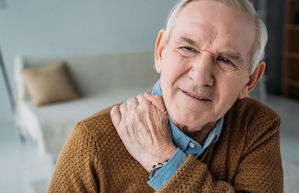The first sign many of us have of this stealthy, potentially deadly condition is usually a fracture – often of the wrist, simply from putting out a hand to break a fall. This strongly suggests you have “porous bones” (which is what ‘osteoporosis’ means), and you need to ask your health professional about having a bone-mineral density scan to establish this.
Ideally, however, everyone at risk should go for periodic scans before having a fracture. That includes most women over age 50, young women with irregular periods (which can signal low estrogen levels), men with low testosterone, anyone with a family history of osteoporosis (relatives with multiple fractures or humped backs), anyone who’s had extensive bed rest, gets little physical activity, has a slight build, smokes, abuses alcohol, and has a poor diet (low in calcium, vitamin D and phosphorus).
If you have certain diseases you are also at greater risk, partly through the disease itself and partly through the medications it will often require. Ask about getting your bone density checked if you have rheumatoid arthritis, gastrointestinal disease, Type 1 and Type 2 diabetes, asthma, lung disease, kidney disease, thyroid disease, certain cancers, HIV and depression, says Teréza Hough, CEO of the National Osteoporosis Foundation of SA (Nofsa).
Make lifestyle changes
If you’re diagnosed with osteoporosis, there are lifestyle changes that can help. Watch your diet and include dairy products and dark green leafy vegetables for calcium, get 10-20 minutes of sunlight a day for vitamin D, quit smoking, and cut back on alcohol, caffeine and soft drinks.
Equally importantly, get regular weight-bearing exercise: walk briskly for 20 minutes a day, climb stairs and lift weights or use resistance machines to help retain your bone density. ‘The muscle pull on bone generates electrical charges on bone surfaces which stimulate osteoblast activity and bone formation,’ explains Hough.
Exercise also releases hormones that promote bone formation. It stimulates blood flow in the bone, improves balance and coordination, and strengthens muscles and flexibility, helping to protect you against fractures if you fall.
Explore treatment options
Today there are a number of medications available to help prevent further bone loss (termed ‘resorptives’), and even some to replace or repair bone (‘bone-formation stimulating drugs’).
The resorptives help slow bone breakdown, says Hough. They include:
- Calcium:If you have osteoporosis, you need at least 1000 to 1200mg a day, Nofsa advises. Ask your health professional about taking a supplement.
- Vitamin D:Brief sun exposure may not be enough; if you’re elderly or housebound, you could need 600-800IU a day, says Hough.
- HRT:Hormone replacement therapy can help maintain bone mass for the first five to 10 years after menopause, and prevent fractures by nearly 50%, says Hough. SERMS (selective oestrogen receptor modulators) may also help: ask your health professional.
- Bisphosphonates:These are drugs that help prevent bone density loss by acting directly on the bone, and may reduce hip and spine fractures by more than 50%, Nofsa notes.
- Parathyroid hormone:This has been available in South Africa for over a year and stimulates bone formation while inhibiting bone resorption. It’s been found to ‘significantly reduce’ the risk of hip and spine fractures, says Hough, but is extremely expensive.
It’s vital that you discuss osteoporosis treatment options with your health professional to find out which are available to you, and would best suit your specific health needs and finances.
For more information, contact the National Osteoporosis Foundation, www.osteoporosis.org.za, 0861 102 265.
IMAGE CREDIT: 123rf.com

